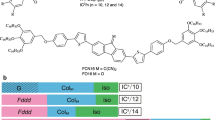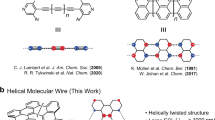Abstract
In this paper, a novel theory of optical activities for helical polymers has been formulated using crystal orbital methods under periodic boundary conditions. The selection rule of the optical transition was determined in the reciprocal space based on the helical angle of the unit cells. The optical rotatory strength was estimated using Wannier functions, which can be chosen to be real localized orbitals. Contrary to conventional exciton models, the structural parameters of helical polymers can be easily reflected in actual calculations of the optical rotatory strength within the crystal orbital framework. The theory was confirmed by evaluating the optical rotatory strength of a right-handed helical polyacetylene. This approach provides a promising method to evaluate the optical activities of helical polymers with itinerant electrons.






Similar content being viewed by others
Data availability
The datasets generated during and/or analysed during the current study are available from the corresponding author on reasonable request.
References
Woody RW (1996) Theory of circular dichroism of proteins. In: Fasman GD (ed) Circular dichroism and conformational analysis of biomolecules. Plenum Press, New York, p 25
Lightner DA (2000) The octant rule. In: Berova N, Nakanishi K, Woody RW (eds) Circular dichroism: principles and applications, 2nd edn. Wiley, New York
Moffitt W, Woodward RB, Moscowitz A, Klyne W, Djerassi C (1961) J Am Chem Soc 83:4013
Moscowitz A (1962) Adv Chem Phys 4:67
Moffitt W (1956) J Chem Phys 25:467
Moffitt W, Fitts DD, Kirkwood JG (1957) Proc Nat Acad Sci 43:723
Tinoco I Jr (1962) Adv Chem Phys 4:113
Charney E (1965) Tetrahedron 21:3127
Kemp CM, Mason SF (1966) Tetrahedron 22:629
Gould RR, Hoffmann R (1970) J Am Chem Soc 92:1813
Imamura A, Hirano T, Nagata C, Tsuruta T (1972) Bull Chem Soc Jpn 45:396
Botek E, Champagne B (2007) J Chem Phys 127:204101
Grimme S, Peyerimhoff SD, Bartram S, Vögtle F, Breest A, Hormes J (1993) Chem Phys Lett 213:32
Hatanaka M (2013) Int J Quantum Chem 113:2447
Stephens PJ, Devlin FJ, Cheeseman JR, Frisch MJ (2001) J Phys Chem A 105:5356
Autschbach J, Ziegler T, van Gisbergen SJA, Baerends EJ (2002) J Chem Phys 116:6930
Autschbach J, Patchkovskii S, Ziegler T, van Gisbergen SJA, Baerends EJ (2002) J Chem Phys 117:581
Diedrich C, Grimme S (2003) J Phys Chem A 107:2524
Ikai T, Okamoto Y (2009) Chem Rev 109:6077
Shimomura K, Ikai T, Kanoh S, Yashima E, Maeda K (2014) Nat Chem 6:429
Yashima E, Maeda K, Iida H, Furusho Y, Nagai K (2009) Chem Rev 109:6102
Megens RP, Roelfes G (2011) Chem Eur J 17:8514
Leigh T, Fernandez-Trillo P (2020) Nat Rev Chem 4:291
Natta G, Pino P, Corradini P, Danusso F, Mantica E, Mazzanti G, Moraglio G (1955) J Am Chem Soc 77:1708
Akagi K, Piao G, Kaneko S, Sakamaki K, Shirakawa H, Kyotani M (1998) Science 282:1683
Akagi K, Mori T (2008) Chem Rec 8:395
Green MM, Peterson NC, Sato T, Teramoto A, Cook R, Lifson S (1995) Science 268:1860
Mayer S, Zentel R (2001) Prog Polym Sci 26:1973
Tang H-Z, Lu Y, Tian G, Capracotta MD, Novak BM (2004) J Am Chem Soc 126:3722
Tang H-Z, Novak BM, He J, Polavarapu PL (2005) Angew Chem 117:7464
Schwartz E, Koepf M, Kitto HJ, Nolte RJM, Rowan AE (2011) Polym Chem 2:33
Yashima E (2010) Polym J 42:3
Nakano T, Okamoto Y (2001) Chem Rev 101:4013
Hoffmann R (1963) J Chem Phys 39:1397
Imamura A (1970) J Chem Phys 52:3168
Pople JA, Walmsley SH (1962) Trans Faraday Soc 58:441
Pugh D (1973) Mol Phys 26:1297
Marzari N, Vanderbilt D (1997) Phys Rev B 56:12847
Stewart JJP (2013) J Mol Model 19:1
Stewart JJP, (2016) MOPAC2016, Stewart computational chemistry, Colorado Springs CO, Available at: http://OpenMOPAC.net
Acknowledgements
This work was supported by JSPS KAKENHI Grant Number JP19K05392.
Author information
Authors and Affiliations
Corresponding author
Additional information
Publisher's Note
Springer Nature remains neutral with regard to jurisdictional claims in published maps and institutional affiliations.
Rights and permissions
About this article
Cite this article
Hatanaka, M. Optical activities of helical polymers: a crystal orbital theory based on Wannier functions. Theor Chem Acc 140, 153 (2021). https://doi.org/10.1007/s00214-021-02843-9
Received:
Accepted:
Published:
DOI: https://doi.org/10.1007/s00214-021-02843-9




